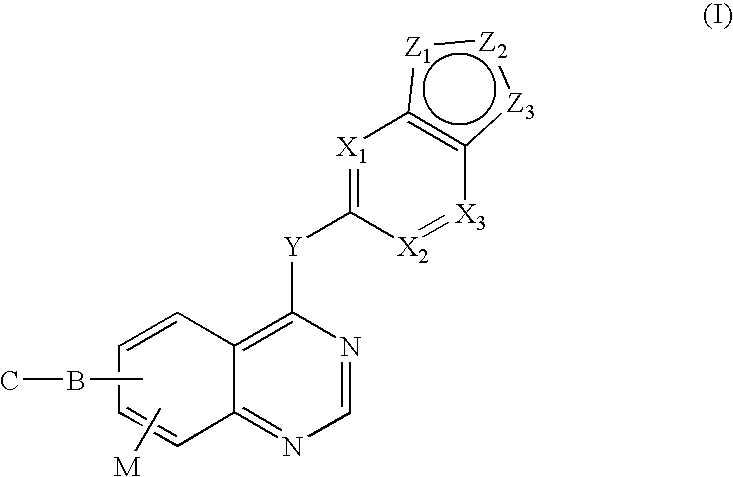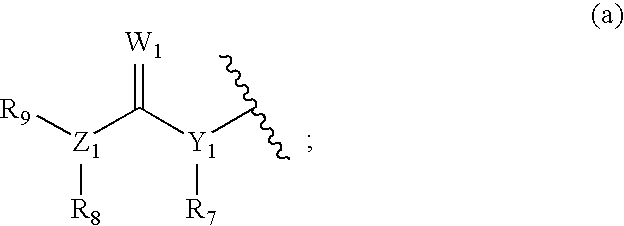Vegfr inhibitors containing a zinc binding moiety
a zinc binding and inhibitor technology, applied in the field ofvegfr inhibitors containing zinc binding moiety, can solve the problems of limited ability to use such combinations, limited treatment regimes using cytotoxic cocktail drugs, and high effort directed to identifying ways to modulate protein kinase activity, etc., to achieve enhanced and unexpected effects
- Summary
- Abstract
- Description
- Claims
- Application Information
AI Technical Summary
Benefits of technology
Problems solved by technology
Method used
Image
Examples
example 1
Preparation of 7-(4-(benzofuran-5-ylamino)-7-methoxyquinazolin-6-yloxy)-N-hydroxyheptanamide (Compound 2)
Step 1a. 2-Bromo-1-fluoro-4-nitrobenzene (Compound 102)
[0146]To a sulfuric acid (50 ml) solution of compound 101 (8.75 g, 500 mmol) was added 68% HNO3 (4 mL) in such a way that the temperature of the reaction was maintained below 40° C. After the addition, the mixture was stirred at 20° C. for 1 h. The mixture was diluted with 300 mL of ice-water and filtered. The collected solid was recrystallized from petroleum ester to yield the title compound 102 as a white solid (8.06 g, 73.3%): 1H NMR (DMSO-d6): δ 8.6 (dd, 1H), 8.3 (m, 1H), 7.7 (t, 1H).
Step 1b. ((2-Fluoro-5-nitrophenyl)ethynyl)trimethylsilane (Compound 103)
[0147]A mixture of compound 102 (2.5 g, 11.4 mmol), triphenylphosphine (0.114 g, 0.44 mmol), palladium (II) chloride (0.045 g, 0.26 mmol) and triethylamine (28 ml) was stirred and heated to 100° C. under nitrogen for 16 hours. The mixture was cooled to room temperature an...
example 2
Preparation of 7-(4-(benzofuran-5-ylamino)-6-methoxyquinazolin-7-yloxy)-N-hydroxyheptanamide (Compound 6)
Step 2a. Methyl 4-(benzyloxy)-3-methoxybenzoate (Compound 202)
[0158]To a mixture of compound 201 (18.2 g, 0.1 mol), potassium carbonate (34.55 g, 0.25 mol) in N,N-dimethylformamide was added benzylbromide (14.5 ml, 0.105 mol) dropwise. The reaction was then heated to 60° C. and stirred for 2 hours. The mixture was cooled to room temperature and was filtered. The filtrate was concentrated and the residue was dissolved in ethyl acetate 500 mL. The organic layer was washed with water and brine (100 mL), dried over MgSO4, filtered and concentrated to give the title compound 202 as a white solid (26 g, 95%): LCMS: 273 [M+1]+.
Step 2b. Methyl 4-(benzyloxy)-5-methoxy-2-nitrobenzoate (Compound 203)
[0159]A mixture of HNO3 (45 mL, 0.963 mol) and HOAc (45 mL) was placed in an ice-bath and stirred. Compound 202 (10.3 g, 50 mmol) in 200 ml HOAc was added dropwise. After addition, the reaction ...
example 3
Preparation of 5-(4-(4-fluoro-2-methyl-1H-indol-5-yloxy)-6-methoxyquinazolin-7-yloxy)-N-hydroxypentanamide (Compound 9)
Step 3a: 1-(2,3-Difluoro-6-nitrophenyl)propan-2-one (Compound 302)
[0167]To a suspension of sodium hydride (5.42 g, 226 mmol) in THF (100 mL) was added ethyl acetoacetate (29.4 g, 226 mmol) while keeping the reaction temperature below 15° C. The mixture was stirred for 15 min. after completion of addition. To the mixture a solution of compound 301 (20.0 g, 113 mmol) in THF (150 mL) was added while keeping the reaction temperature below 5° C. The mixture was then stirred for 24 h at room temperature. The solvent was removed in vacuo and the residue was partitioned between ethyl acetate and 2N aqueous hydrochloric acid. The organic layer was washed with water, brine, dried over MgSO4 and concentrated. To the residue was then added concentrated hydrochloric acid (400 mL) and acetic acid (300 mL) and the mixture was refluxed for 12 h. After cooling, the mixture was conce...
PUM
 Login to View More
Login to View More Abstract
Description
Claims
Application Information
 Login to View More
Login to View More - R&D
- Intellectual Property
- Life Sciences
- Materials
- Tech Scout
- Unparalleled Data Quality
- Higher Quality Content
- 60% Fewer Hallucinations
Browse by: Latest US Patents, China's latest patents, Technical Efficacy Thesaurus, Application Domain, Technology Topic, Popular Technical Reports.
© 2025 PatSnap. All rights reserved.Legal|Privacy policy|Modern Slavery Act Transparency Statement|Sitemap|About US| Contact US: help@patsnap.com



